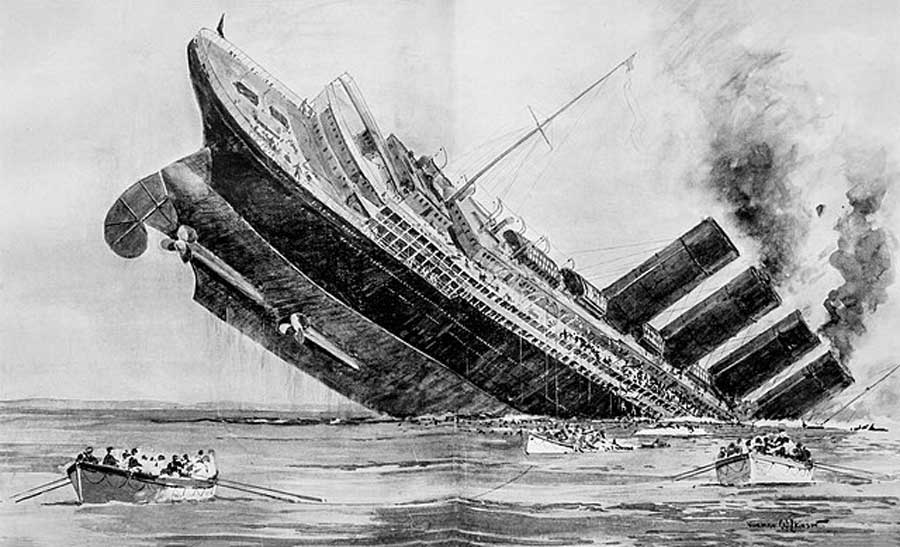This is the fourth and final chapter of our series, “The American Dream Torpedoed.” To recap, Jack Inman immigrated to America on May 3, 1913. The Ellis Island authorities welcomed him and wished him the best of success. He arrived in Park City soon thereafter and secured employment at the Silver King Mine. He distinguished himself as an exceptional miner; Management compensated him accordingly. By April 1915 he was professionally, financially, and personally secure.
Before leaving Great Britain, Jack promised his parents that he would return to visit them. He resolved to honor that commitment with an unannounced trip. He reserved a third-class ticket on the top-of-the-line passenger ship, the Lusitania. He happily paid a premium to experience Cunard’s legendary service. Compared to its transatlantic competitors, third class on a Cunard liner was most enjoyable. Three sumptuous meals a day, shared cabins with their own flush toilets, and a lounge area featuring a piano.
The “Lucy” was set to sail on Saturday, May 1, 1915 and arrive in Liverpool, England on Friday, May 7. It was to be her 202nd crossing of the Atlantic, another routine performance.
German submarine U-20 had other plans.
The ship was booked nearly to capacity – 1,960 passengers and crew (stowaways not included). The topic of Germany’s unrestricted submarine warfare against British ships dominated passenger conversations. Cunard executives, Captain William Thomas Turner included, dismissed the threat.
Capable of sustaining 25 knots (almost 30 mph), the Lusitania could outrun any submarine. Additionally, she was constructed to military grade specifications – essentially a battleship masquerading as a luxury liner. Another comfort to passengers: in its 75 years of operation Cunard had never experienced “a company caused” passenger fatality. Bravado aside, there was an issue that would soon manifest itself. The Lusitania’s conception (1903) predated Germany’s practical application of submarines and torpedoes. As a result, her hull possessed a fatal design flaw (longitudinal bulkheads). The impact of a single torpedo could sink her.
By all measures, the crossing had been routine. By Friday May 7, Jack’s joyous reunion with his parents would occur in less than a day. At 2 p.m. the second seating for lunch was underway. The dining room for third class was Salon Deck D near the bow of the ship. U-20’s torpedo impacted at 2:10 p.m., just below and behind Salon Deck D. It’s doubtful that those enjoying lunch had much time to comprehend what happened. The massive ship shuddered. A second mystery explosion immediately followed (likely a secret cache of munitions). The Lusitania sank in 18 minutes. Of the 1,960 souls on board, 1,197 perished, including 128 Americans.

Credit: Engraving by Norman Wilkinson, The Illustrated London News, May 15, 1915. Courtesy of Wikimedia Commons.
The disaster garnered front page headlines. Public outcry was immediate and universal. America’s perception of both the war and Germany experienced a sea change. Jack’s parents had no idea he was on the Lusitania. For them, a parent’s worst nightmare would soon become a reality.
The close-knit community of Park City hoped for the best but feared the worst. On Saturday May 8, the Park Record reported on the tragedy, expressing both worry for J.E. Inman and conveying the town’s outrage. The next edition confirmed that Jack was “not on the list of survivors.” His body was never recovered.
It would take twelve months to settle Jack’s affairs. Parkite W.R. Jefford, a lawyer and clerk of the Maccabee Fraternal Order would assist Jackson Inman (Jack’s father) to do so – Jack’s life insurance policy required proof of death (meaning a body) to pay out the policy.
For the Inman family, two American Dreams were torpedoed on that fateful Friday – Jack’s quest for a better life and his parents aspirations for him.
Our next member’s only hike goes up to Inman’s place of work: the Silver King Mine. To sign up for our hikes to historic locations, become a member today!